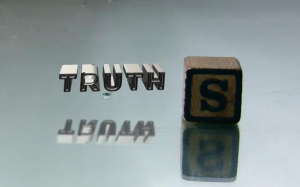
Out of the poems here, the ones that interested me the most were “The Ballad of Soot and Harry Sand” by Stephanie Strickland, and “MUDs” by David Jhave Johnson.
I thought that “The Ballad of Soot and Harry Sand” was engaging because not only does it offer unique characterization, but also has a multilinear quality that reminded me of some of the other pieces of e-literature we read in class. Truth be told, I didn’t really enjoy a lot of the digital poetry until I read this piece.
I believe it is part traditional poem (it does follow a narrative and the words do make sense, unlike some of the Dada and Dada-inspired poems both mentioned by Rettburg and within this module) but also part Lettristic, as a lot of the poem seems to rely on the sound of the words. For example, this section:
1
Tangy Soot. Tang-I-Bull Soot.
0
Trua-vir Sand. Liv-a-Tru Sand.
Physics: The Movie. R.I.P.,
crown assays in a bathtub,
or Galileo, trekking to the far side
of the valley to touch that blue
boulder on the ridge.
And would this prove he saw
mountains on the moon in any case,
Sand asks.
Or this section:
0
Sand panned speed. Languid was she. Oh seeming fast, fine foil for
de…lay, lo, slow. Some slip…age, she…
1
He, Harry, hurried, harried host.
“Tang-I-Bull” in the first example made me pause, as I read it first phonetically and then as the word ‘tangible,’ which made me go back and reread ‘Tangy Soot’ with a hard ng, like the actual word tangy, and then a soft g as in the word tangible. There are also a lot of cases where it seems the author used particular word combinations both for the meaning and for the intense alliteration. There are some other words and combinations such as the sentences “Trua-vir Sand. Liv-a-Tru Sand.” where I wasn’t sure if they held a deeper meaning or not. I tried googling the words and some other variations and couldn’t find anything, but thought it might mean “live a true” as in Sand being blunt and true to himself–or else just an interesting combination of sounds. If anyone else read this piece and has feedback or ideas about this I would love to hear them.
The second example I included because it did some character work as well as played more with the sounds of words as well as the meaning.
Another reason I liked this piece because it kept giving me cause to pause and reassess the characters. At times I wondered if Sand was actually a computer or program, because she was continuously associated with binary, light, glass, colors, and other computer related imagery, such as “a screen of violet / silver unscrolled,” while Harry Soot is compared to much more mundane, human scenes, such as grinding his keys in his pockets, defacing his Metrocard.
Sand is also surrounded with both musical and natural metaphors, though, so after reading it through a few times I think that they are both human. All in all, it was a really intriguing poem about two people, and I thought the multilinear nature of it really enhanced the experience by inviting the reader to become involved with the story of it.

To be honest, I’m not sure if I actually like MUDs, or if I’m just intrigued by it. I did really enjoy “Because,” and I believe that the others are very visually appealing, but a lot also made me uncomfortable. I did not like “Fur” for that reason, and I didn’t think it was interesting enough either to make up for that discomfort.
Another one that I liked was “Truth.” I believe that “MUDs” overall is a great example of concrete poetry, as the shape of the title word plays a huge part in shaping the meaning of the poem. In “Truth” in particular, the meaning would be incredibly altered if it was displayed in static text, or even in the same video but with the word ‘TRUTH’ simply hanging unchanging. Similarly, in the poem “Because,” the title word growing increasingly mangled adds a lot of depth to the poem in a way that would be impossible to replicate on paper. Overall, I am not in love with these poems, but I respect the idea behind them.